Ohio Attorney General Dave Yost, a likely upcoming contender for governor, would have been the sole surviving official in the state’s gubernatorial line of succession had a catastrophic event occurred last year during the annual State of the State address in downtown Columbus, an analysis by our media organization has discovered.
As the Second Cold War heats up and concerns over terrorism remain, the reality, we would uncover, is that the absence of an official in position for succession is an exception, not the rule. Likewise, each political party, both Republican and Democrat, often do little, if anything, to ensure continuity of both the State’s Chambers, the Ohio House and Senate, in an event that could likely kill or incapacitate a majority, or as we found, a near totality of representatives, a threat that hasn’t been given adequate consideration.
Ohio isn’t unique in that regard, far from it we would find. The state does what nearly all of them do, what they have all always done, even during the Cold War, placing nearly its entire elected state-wide officials and representatives in one room, a tradition that has continued even after the attacks of September 11.
At the federal level, the United States Government has a member of the presidential line of succession, a ‘Designated Survivor,’ abstain from large gatherings, like presidential inaugurations, taken away to a secure bunker or kept in the air, guarded by various military assets; Members of Congress also select their own to be absent, ensuring the survival of our legislative branch of government.
Gatherings of that magnitude, such as what will occur Thursday night as President Joe Biden delivers his 2024 State of the Union address, are some of the most dangerous for our democracy, often with foreign powers devising military actions around the speech – it was a linchpin of the former Soviet Union’s first strike strategy.
Biden’s upcoming speech in the House Chamber would also be an ideal time for China, which is 13 hours ahead of Washington, D.C., to strike Taiwan – guaranteeing them a delayed decision on military support of the island. Due to national security concerns, certain protective actions, selectees and designated locations, while uncovered, have been withheld.
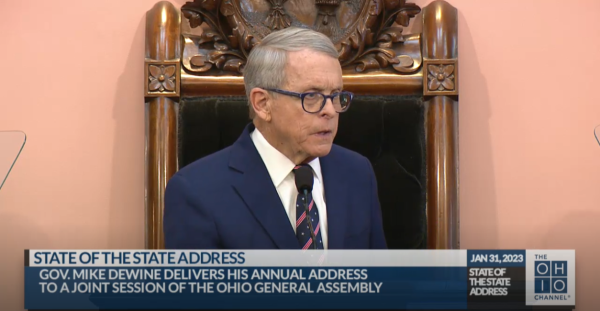
Like the traditional State of the Union address given by the President of the United States, for quite some time, it has also been customary for the Governor of Ohio to speak before a joint session of the Ohio House and Senate; often he brings along members of his Cabinet, and his wife is always up in the balcony. Like its federal equivalent, the governor speaks about policy, budget and objectives for the year, his words broadcast via the airways to homes and phones across the state.
Each governor has their own twist on things, some have given short speeches and others make the speech more conversational. Then there are still others yet like former Governor John Kasich who did things radically different. Instead of speaking in the House Chamber before a joint session of the Ohio Legislature, he took the annual event on the road to various locations across the state. In 2018, for example, for his eighth and final State of the State address, the speech was given at Otterbein University in Westerville. When now Governor Mike DeWine was elected to the position, he returned it to its traditional place at the Statehouse in downtown Columbus.
The Ohio Constitution puts the Lieutenant Governor, the President of the Senate and then the Speaker of the House of Representatives in the gubernatorial line of succession, in that order. The Ohio Revised Code adds the remaining state-wide elected offices of Secretary of State, Treasurer of State, Auditor of State and Attorney General to that line, it also makes clear that no ’emergency interim successor’ to those four aforementioned positions may serve as governor.
During the State of the State address each year, it is tradition that the Lieutenant Governor is in attendance. Both the President of the Senate and the Speaker of the House of Representatives have ceremonial and procedural roles during the joint session. The attendance of the remaining four is all but a guarantee.
In 2019, for DeWine’s first State of the State address, all members of the gubernatorial line of succession were in attendance, as well as all seven members of the Ohio Supreme Court. Due to the pandemic, there was no address in 2020 and 2021. During the 2022 State of the State address, again all members of the gubernatorial line of succession were in attendance. That would have been the same for 2023 as well if it wasn’t for the absence of Attorney General Dave Yost.
Yost had commitments in Washington, D.C. that had him waiting at the John Glenn Columbus International Airport for a 12:26 p.m. American Airlines flight during the first half of DeWine’s speech. He was up in the air reading one of Michael Sandel’s books as the plane took off and headed eastward toward the nation’s capital; he wouldn’t land until the speech was over and all the officials had dispersed.
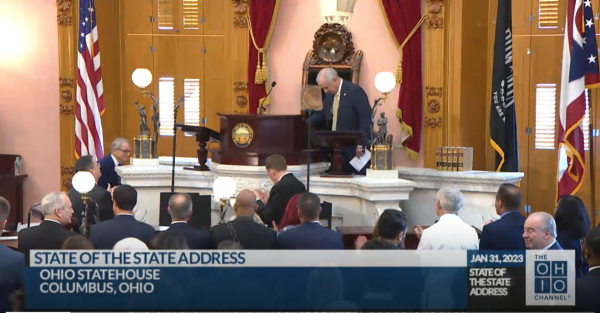
As for members of the Ohio House and Senate, all but a select few were in attendance, as is typical each year. In the Ohio House of Representatives, all the Democrats were in attendance and only three Republicans were absent, two for illnesses and one for private business. In the Ohio Senate, all the Democrats were again in attendance with three Republican senators absent, one for private business, one on a medical trip and one for a matter that was excused but not disclosed.
During that State of the State address on January 31, 2023, Yost wasn’t the only state-wide elected official missing. Of the seven Supreme Court Justices, three were absent. Justice Melody Stewart, for example, was in Cleveland speaking to students at an elementary school; Justice Patrick Fischer and Justice Michael Donnelly also both had commitments in other parts of the state. While Justices of the Supreme Court are elected by voters across the entire state, just like the governor or many of the others in the gubernatorial line of succession, they are not able to fill in as the chief executive but would likely be able to determine the constitutionality of what to do if all eligible replacements were unable to fulfill the role until the people of Ohio could elect a new governor.
Ohio is in a better position than most, some states like Alaska only place the Lieutenant Governor in the gubernatorial line of succession, while others like Wyoming, which doesn’t have a position of Lieutenant Governor, places its Secretary of State next in line, with no one designated after to succeed to the highest position in the state; South Dakota is the same with only the Lieutenant Governor capable to becoming governor should the need arise. Eight states, Connecticut, Georgia, Idaho, Maryland, North Dakota, Pennsylvania, Rhode Island and Wisconsin, only have two listed successors to the governorship, in four of those after the Lieutenant Governor, the next in line comes from the State’s Senate, in two of them, the next in line is the Speaker of the State’s House of Representatives, and in two, the individual next in line is a statewide elected official. In Pennsylvania, the Governor and Lieutenant Governor are both Democrats, but the President Pro Tempore of the Senate, the second in line to be governor, is a Republican.
On the opposite end of the spectrum, some states like Texas have 18 office holders in the gubernatorial line of succession, the Lieutenant Governor, the President Pro Tempore of the Senate, the Speaker of the House of Representatives, the Attorney General and then the 14 Chief Justices of the Texas Courts of Appeals, in numerical order. Oklahoma has 11, but only the first three, the Lieutenant Governor, the President Pro Tempore of the Senate and the Speaker of the House of Representatives, could remain at the post long term, the rest can only serve as an emergency interim governor, but those spots include statewide elected officials like the Attorney General and State Treasurer. Some states like North Carolina have 10 officials who could become the governor, for which the next in line is the Lieutenant Governor, who in North Carolina is elected separately from the Governor, and at present time is of an opposite political party.
It isn’t abnormal for the seat of a state’s governor to become empty, which could be due to anything from a death to being convicted of federal criminal charges. In Ohio, for example, both Governor John Brown and Governor Nancy Hollister became governor while serving as the lieutenant governor and thus succeeded to the higher post, neither served for more than a month. In 2023, New Jersey Governor Phil Murphy was vacationing in Italy when his Lieutenant Governor Sheila Oliver died, thus making Senate President Nicholas Scutari, who was second in the gubernatorial line of succession, acting governor until Murphy’s return.
In Ohio, in case of a vacancy in the office of Lieutenant Governor, Secretary of State, Treasurer, Auditor or Attorney General, the governor appoints a replacement; a vote of a majority of the members elected to each house of the General Assembly must confirm the appointment of Lieutenant Governor. When a vacancy occurs in the Ohio House or Senate, members of the same party, of the same chamber, select a replacement.
In each biannual session of the Ohio General Assembly, who consist of 99 members in the Ohio House of Representatives and 33 members in the Ohio Senate – for a total of 132 representatives, it is common for members to retire before their term is complete for various reasons, from taking another job or higher elected office to vacating the position early to allow a desired successor to be chosen; typically though, it’s less than a handful every two years.
For this current 135th Ohio General Assembly, which convened on January 3, 2023, and will adjourn on December 31, 2024, only six members have left office. In the Senate, Frank Hoagland (R) retired on December 1, 2023, and was replaced on December 6, 2023, by Brian Chavez (R). In the House, five members, three Republicans and two Democrats, have left office, one after being appointed by Gov. DeWine to become his Director of the Department of Agriculture, one after being appointed to become her county’s clerk of courts, one who chose to retire and spend time with family, one because the representative died while in office and another after being arrested on domestic violence charges; four of those five have had a successor appointed to their vacated seat.
Republicans hold a supermajority in both houses, giving them a quorum without needing (at least in theory) any presence or support from their Democrat colleagues. The rules of the Ohio House of Representatives, for example, state that ‘a majority of all members elected must be present to constitute a quorum to do business.’ The rules also state that ‘in no event may business be conducted unless a member of the majority party is present.’ Likewise, the Ohio Senate rules state that a majority of all members elected to the Senate shall constitute a quorum.
According to the Secretary of State’s Office and vacancy guidelines, which follow the Ohio Constitution and Revised Code, the only way to replace members of either the Ohio House of Representatives or the Ohio Senate is by members of the same party electing them to the vacated seat or by election in their districts. In previous sessions of the General Assembly, such as in the appointment of Representative Elgin Rogers (D) or Senator Paula Hicks-Hudson (D) in 2022, the Democrats only needed a quorum of their members for either appointment to be successful.
The question then becomes what happens when there are only a few members of a party remaining, or none at all, unable to establish a quorum to appoint new members or even open a session of either the House or Senate. What happens when there isn’t an official in the gubernatorial line of succession able to take the post and therefore unable to appoint anyone to the other statewide elected offices, including the Supreme Court? What happens when there isn’t a Supreme Court or only a few members are remaining and thus unable to establish a quorum of their body to provide guidance? The reality is, while extremely unlikely, there is a potential constitutional crisis just beyond the horizon.
The matter has been raised in other states before but many just rely on the assumption that someone within the federal government, maybe a federal judge, maybe the United States Supreme Court, would intervene in such a one-off event, bending the rules to prevent a constitutional crisis; who they would pick is anyone’s guess. It’s also not as if Ohio doesn’t have a secure facility where a few select ‘designated survivors’ in the Ohio House and Senate, or even just one ‘designated survivor’ in the gubernatorial line of succession could spend a few hours watching the speech remotely, maybe while enjoying a pizza.
That site would likely be the Ohio Emergency Management Agency’s nuclear-resistant bunker, which could protect against almost anything besides a direct nuclear strike, located adjacent to The Ohio State University Airport. Featuring a high-security perimeter, interior doors with card-access locks, a vast communication array, an emergency operations room, executive and administrative suites and dispatch consoles, the site is the best state-owned building for any such designated survivor or survivors.
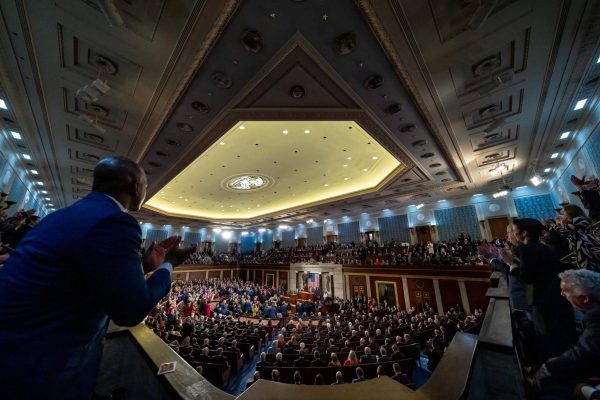
While a catastrophic event at the Ohio Statehouse would be devastating, the state would eventually move on, the country would be shaken up, but for it too, life would continue mostly as normal, as we did after the attacks of September 11. The true threat, the ‘big one,’ would be an attack on the nation’s capital during the State of the Union. Should a nation, such as China, seek a first strike against the United States, even non-nuclear, it would likely be at a time when the country is most susceptible, the State of the Union; an attack which could even be carried out by a proxy terrorist organization.
The concern during the First Cold War that the Soviets might do just that led to a member in the presidential line of succession being absent from the event, typically someone from the cabinet, who is confirmed by the Senate. In the early years, legend has it that selectees walked around D.C. or stayed at their home, well within the potential blast of a nuclear attack on the Capital Building, where the speech is given. The first publicly identified ‘Designated Survivor’ actually wasn’t for the State of the Union but for a February 1981 Presidential Address to a Joint Session of Congress by President Ronald Reagan. Secretary of Education Terrel Bell was the ‘Designated Survivor’ – it is not publicly known where he went.
That tradition has followed through for many years, most recall the moment they find out that they have been selected as the ‘Designated Survivor’ as a disappointment, being away from the grand ceremonial event that is the State of the Union.
At the end of the 20th century, after the fall of the Soviet Union, then Secretary of Housing and Urban Development, Andrew Cuomo, served as President Bill Clinton’s absent cabinet member in January 1999 for his boss’s second to last State of the Union.
Guarded by Secret Service agents and with military officers by his side, Cuomo would have become President had the unthinkable happened. He waited out the address with his family at their home in Virginia; he was also given an intelligence briefing and granted standby access to the nuclear launch codes.
During President George W. Bush’s first year in office, he gave what is called a Presidential Address to a Joint Session of Congress; it is very similar to a State of the Union address, but is given by the President in his or her first year in office or when the officeholder wants to give a special address, such as President Barack Obama’s 2009 Health Care Speech to Congress.
Anthony Principi, Bush’s Secretary of Veterans Affairs, was the ‘Designated Survivor’ for that speech in early 2001. Unlike many such designees, Principi fit the bill of someone destined to become president, someone the nation would rally behind. An athlete and student council president at his high school, he attended the United States Naval Academy and served in the Vietnam War. He earned his law degree and worked as a lawyer in the military. After retirement from the armed forces, he served in many administrative roles within the civilian side of the government, before ultimately being confirmed to the cabinet.
Unlike many selectees, Principi never spoke publicly about his role as the ‘Designated Survivor’ before being contacted by Y-City News, except to help out for the television show which boasts the name of the service he gave to his country on February 27, 2001.
“Yes, I was taken away the day of the State of the Union address,” recalled Principi. “There’s always someone in the line of succession to the Presidency who needs to be protected, needs to be away.”
As Principi detailed, he was the only one absent from the address that day. Unlike many of those before and after him who served as the ‘Designated Survivor,’ Principi wouldn’t say where exactly he was taken.
“I was taken to an undisclosed location, it happened to be under a mountain, and I remained there for the duration of that day, that night, and came back the following day,” Principi recalled. “It’s to ensure that in the event of some catastrophic event, let’s just assume for the moment they hit the Capital when the President was speaking at the State of the Union address, and everyone was there, you can understand the gravity of the situation, so for succession purposes, they have a designated survivor.”
Other times, such as with last year’s designee, Labor Secretary Marty Walsh, selectees are less fitting for the role, having already accepted the position to become Executive Director of the NHL Players’ Association with the news leaking the day of the State of the Union, something that should a catastrophe have occurred, would jeopardize his legitimacy in the eyes of Americans.
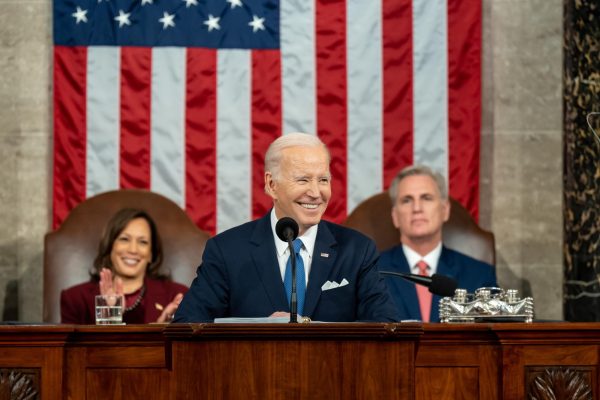
Walsh wasn’t the only one missing from last year’s address, but he was the most publicized. It’s well known that both the House and Senate each have their own ‘designated survivors’ but rarely is that ever publicly communicated. California Representative, Democrat Mike Thompson, gave a local outlet the exclusive that he was indeed selected and would be away at an ‘undisclosed location,’ a role he said was bestowed onto him by House Minority Leader Hakeem Jefferies; he had served in that role multiple times before.
Illinois Representative, Republican Mary Miller, was also absent, but her official excuse was that she was boycotting the speech, she said it was because she didn’t want to ‘listen to him (the President) lie about the damage he has caused to our country while the left-wing media and members of congress applaud his lies.’ It is a policy of Congress not to officially contradict members as to the reason for their absence if stated for political reasons; communications with her staff were less than forthcoming with our outlet being directed to a podcast where the Representative reiterated her reasons for not attending.
Each of Ohio’s 15 Congressmembers and Senator J. D. Vance attended the State of the Union; Senator Sherrod Brown could not be seen in any photographs or video of the address, and his staff ignored multiple means of contact to identify a purpose for his absence.
According to numerous Congressional staffers, typically, the address is extremely well attended, with each state having nearly perfect attendance. Y-City News reached out directly to each congressperson and senator in Ohio’s surrounding states, as well as others in each chamber’s high seniority, but due to national security concerns, we are not publishing those who we identified were missing that were not previously publicized.
Some members of Congress, like Senator Dianne Feinstein, were absent, having chosen to watch the State of the Union remotely at her residence; she was the senior-most member, by the date of assumed office, in the Democratic Party for her chamber when the 2023 State of the Union occurred. Until recently, that would have meant she was the President pro tempore of the United States Senate, the third in line for the presidency, but after 9/11, the position was given to someone just a shy younger, but still who held significant seniority; in March 0f 2023, that was Senator Patty Murray of Washington, who before Senator Feinstein’s passing was the second-most senior Democrat senator. Now at 73 years old, she retains that position and is the most senior Democrat senator. Republican Senator Chuck Grassley, of Iowa, the senior-most member of his party in the Upper House also didn’t attend the 2023 State of the Union.
Before the horrific attacks of September 11, 2001, the only members of Congress to be missing from the State of the Union were often due to personal reasons, such as health, essentially leaving no contingency plans for the legislature. Our research also exposed an uncomfortable reality that has never before been documented, someone within the government disregarded the presidential line of succession.
West Virginia Senator Robert Byrd, an 83-year-old Democrat, was President pro tempore of the United States Senate on Sept. 11, however, he was not evacuated. Tom Daschle recalled seeing Byrd carrying a couple of books, having some difficulty walking quickly. Reporter Dawn Kopecki in 2021 for CNBC recalled seeing the Senator ‘ducking behind a tree’ outside the Capital. The person third in line for the presidency was not whisked away like the others but left to fend for himself.
During 9/11, Secretary of Veterans Affairs, Anthony Principi, was in San Diego, California, to give a speech when he was awakened by FBI agents at his door to take him to a protective location; he was 16th in line for the presidency. Later that day, he was taken to Miramar and put on a plane, one of the few that was allowed to fly, and eventually flown back to the East Coast. Cabinet members, most of whom were eligible for the line of succession, were spread around the country. Secretary of State Colin Powell, for example, fourth in line for the presidency, directly behind Byrd, was outside the United States in Lima, Peru.
Soon after the attacks began to unfold, senior members of Congress were evacuated via helicopters to the Mount Weather Emergency Operations Center, located in the Blue Ridge Mountains, roughly 80 minutes outside the nation’s capital, and taken to the underground bunker beneath. Speaker of the House of Representatives Dennis Hastert, House Minority Leader Dick Gephardt, Senate Majority Leader Tom Daschle, Senate Minority Leader Trent Lott, Senate Minority Whip Don Nickles and other top congressional leaders, as well as members of their staff, were all at the hardened facility that day.
Soon though, it was decided that the nation needed to see its leaders, to reassure them that things were going to be alright, how could the country feel safe if those elected to lead them were underground in protective bunkers? By that evening, roughly 150 members of Congress, including leadership, of both parties, came together on the steps of the Capitol Building.
While 9/11 required continuity of government plans to be enacted, many of which hadn’t ever been fully tested in a real-world event, the nation was protected by the fact that those in the president’s line of succession were scattered around the world. As previously mentioned, the Secretary of State was in Peru, the Secretary of the Treasury, Paul O’Neill, the fifth in line for the presidency, was in Japan, and the Attorney General, John Ashcroft, the seventh in line, was en route to Milwaukee.
The State of the Union is one of the few times a year that all but one person in the line of succession are together. There are exceptions, such as in 2010 when Secretary of State Hillary Clinton was at a conference in London during President Barack Obama’s address; also absent was Housing and Urban Development Secretary Shaun Donovan, the ‘Designated Survivor.’ Had a tragedy occurred, Clinton, not Donovan, would have become president, but policy requires that the ‘undisclosed location’ must be in the United States, most are often assigned Mount Weather, but there are other bunkers capable of housing the designee, but it must be a ‘secure location.’
Four of the nine members of the Supreme Court were absent from the State of the Union in 2023, Justice Sonia Sotomayor, Justice Clarence Thomas, Justice Neil Gorsuch and Justice Samuel Alito. While the attendance of justices varies by year, Thomas, Alito and Sotomayor have made it a practice not to attend; their whereabouts during the event are not publicly disclosed.
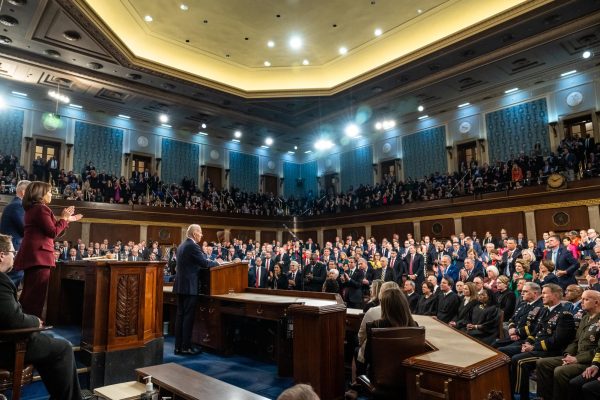
There is also a concern that an attack during the State of the Union would all but effectively destroy Congress’s ability to function. With only a few remaining members, the Senate would lack a quorum, but the Seventeenth Amendment to the Constitution allows state legislatures to empower their governors to appoint replacements. A sizable majority, 46 states, allow the governor to at least temporarily appoint someone to fulfill that role, some without restrictions, like Ohio, and others with restrictions, like Kentucky, that mandate the replacement come from the same political party. The remaining four, North Dakota, Oregon, Rhode Island and Wisconsin, only allow voters in a special election to replace an empty senate seat.
In all but a full-scale nuclear war, a new quorum-eligible Senate would be seated rather quickly, the House of Representatives, however, is where seating new members becomes all but impossible. The Constitution requires that vacancies in the House be filled through an election, nearly always resulting in a special election, such as in 2018 when Representative Pat Tiberi resigned on January 31; the special primary was held alongside the regular primary in May and a special general election was held in August, where then State Senator Troy Balderson was elected to Congress.
Following 9/11, there were many lengthy discussions had in Congress about creating some sort of emergency solution should the unthinkable happen, but no legislation was ever codified.
Now declassified documents show that the Soviet Union, during the First Cold War, recognized this vulnerability and it was deemed the best time for a first strike against the United States. While now there is a ‘Designated Survivor’ during the address, kept safely underground in a secure bunker – often at Mount Weather, the confusion of even a possible military move could lead to everyone being evacuated.
Presently, the biggest concern is that China will move on Tawain while President Biden is giving his 2024 State of the Union address which begins at 9 p.m. Thursday. With Asia 13 hours ahead of Washington, D.C., the event would occur at 10 a.m. China-Taiwan time. If minutes into Biden’s speech China launched a full-scale barrage on the island of Tawain, with cruise missiles and rockets, supported with cyber and infrastructure attacks, it would be one of the only times the country could guarantee a delayed American response.
If China targeted broadcast systems in the United States, they could worsen the confusion by having Americans see the President be whisked out of the House Chamber only for their feeds to then go dark from a cyber-attack, combined with other such attacks on cell networks and the like, they could buy themselves at least a critical hour without American military response which may be just enough time to complete the first wave of the assault and guarantee United States assets wouldn’t engage until it’s too late.
Blackwater Founder Erik Prince, a defense industry expert and former Navy SEAL, for example, is just one of many who have publicly said they believe China will attack Taiwan in early 2024. China’s President, Xi Jinping, has told his country to prepare for a conflict and the nation’s reserves of everything from foodstuffs to fossil fuels have been increased recently, indicating preparedness for upcoming shortfalls.
While it’s impossible to say if China will ever attack Tawain, or if they do, when, most unclassified data puts 2024 as the most likely candidate. A presidential election year ensures Biden will add extra thought to defending Tawain, putting American soldiers and contracts in great danger, including with naval assets in the vicinity, susceptible to Chinese hypersonic missiles. If China waits until 2027 and beyond, new leading-edge fabs in the United States will be up and running, significantly affecting China’s ability to impact the American economy with a strike or occupation of advanced semiconductor facilities on the island.
Should China, or any nation for that matter, attempt a decapitation strike against the United States, the country has officials, both in deep underground bunkers and above ground, to ensure a peaceful transition to a newly elected American government while ensuring complete and total destruction of every last man, women and child of the attacking nation, details on that are some of the country’s most closely guarded secrets.

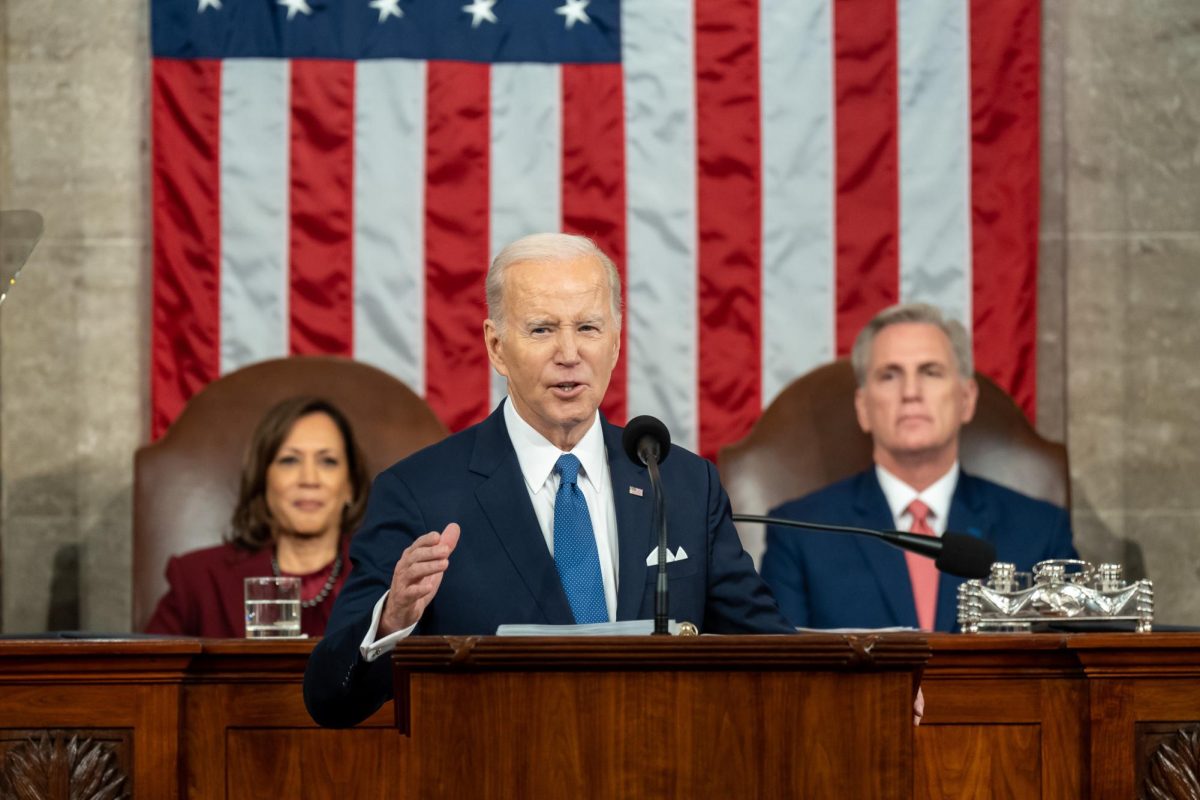
Eva Stine • Mar 9, 2024 at 11:50 am
That was an excellent article. The research you did to give us this information is outstanding. I hope your article gets recognition.
..
Sincerely